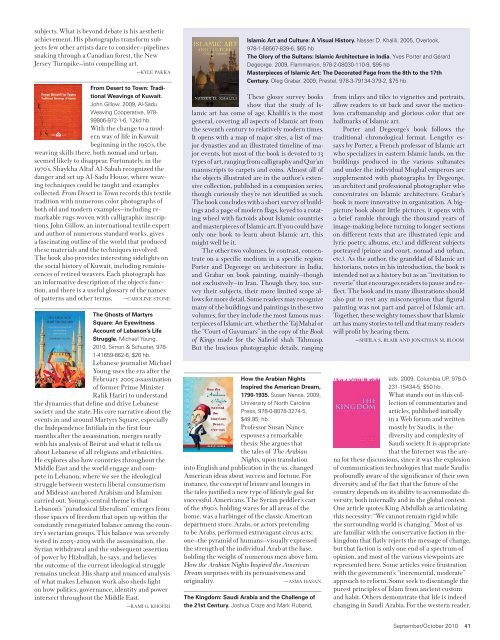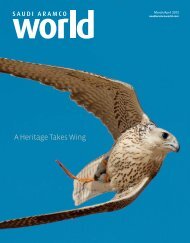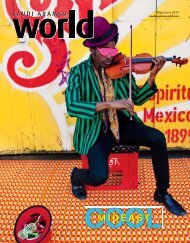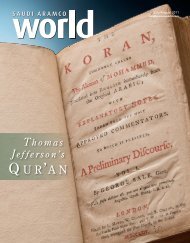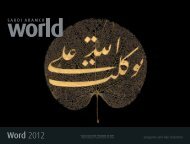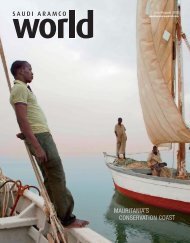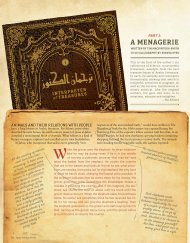ArabicintheSky - Saudi Aramco World
ArabicintheSky - Saudi Aramco World
ArabicintheSky - Saudi Aramco World
You also want an ePaper? Increase the reach of your titles
YUMPU automatically turns print PDFs into web optimized ePapers that Google loves.
subjects. What is beyond debate is his aesthetic<br />
achievement. His photographs transform subjects<br />
few other artists dare to consider—pipelines<br />
snaking through a Canadian forest, the New<br />
Jersey Turnpike—into compelling art.<br />
—KYLE PAKKA<br />
From Desert to Town: Traditional<br />
Weavings of Kuwait.<br />
John Gillow. 2009, Al-Sadu<br />
Weaving Cooperative, 978-<br />
99906-972-1-6, 12kd hb.<br />
With the change to a modern<br />
way of life in Kuwait<br />
beginning in the 1950’s, the<br />
weaving skills there, both nomad and urban,<br />
seemed likely to disappear. Fortunately, in the<br />
1970’s, Shaykha Altaf Al-Sabah recognized the<br />
danger and set up Al-Sadu House, where weaving<br />
techniques could be taught and examples<br />
collected. From Desert to Town records this textile<br />
tradition with numerous color photographs of<br />
both old and modern examples—including remarkable<br />
rugs woven with calligraphic inscriptions.<br />
John Gillow, an international textile expert<br />
and author of numerous standard works, gives<br />
a fascinating outline of the world that produced<br />
these materials and the techniques involved.<br />
The book also provides interesting sidelights on<br />
the social history of Kuwait, including reminiscences<br />
of retired weavers. Each photograph has<br />
an informative description of the object’s function,<br />
and there is a useful glossary of the names<br />
of patterns and other terms. —CAROLINE STONE<br />
The Ghosts of Martyrs<br />
Square: An Eyewitness<br />
Account of Lebanon’s Life<br />
Struggle. Michael Young.<br />
2010, Simon & Schuster, 978-<br />
1-41659-862-6, $26 hb.<br />
Lebanese journalist Michael<br />
Young uses the era after the<br />
February 2005 assassination<br />
of former Prime Minister<br />
Rafik Hariri to understand<br />
the dynamics that define and drive Lebanese<br />
society and the state. His core narrative about the<br />
events in and around Martyrs Square, especially<br />
the Independence Intifada in the first four<br />
months after the assassination, merges neatly<br />
with his analysis of Beirut and what it tells us<br />
about Lebanese of all religions and ethnicities.<br />
He explores also how countries throughout the<br />
Middle East and the world engage and compete<br />
in Lebanon, where we see the ideological<br />
struggle between western liberal consumerism<br />
and Mideast-anchored Arabism and Islamism<br />
carried out. Young’s central theme is that<br />
Lebanon’s “paradoxical liberalism” emerges from<br />
those spaces of freedom that open up within the<br />
constantly renegotiated balance among the country’s<br />
sectarian groups. This balance was severely<br />
tested in 2005–2009 with the assassination, the<br />
Syrian withdrawal and the subsequent assertion<br />
of power by Hizbullah, he says, and believes<br />
the outcome of the current ideological struggle<br />
remains unclear. His sharp and nuanced analysis<br />
of what makes Lebanon work also sheds light<br />
on how politics, governance, identity and power<br />
intersect throughout the Middle East.<br />
—RAMI G. KHOURI<br />
Islamic Art and Culture: A Visual History. Nasser D. Khalili. 2005, Overlook,<br />
978-1-58567-839-6, $65 hb<br />
The Glory of the Sultans: Islamic Architecture in India. Yves Porter and Gérard<br />
Degeorge. 2009, Flammarion, 978-2-08030-110-9, $95 hb<br />
Masterpieces of Islamic Art: The Decorated Page from the 8th to the 17th<br />
Century. Oleg Grabar. 2009, Prestel, 978-3-79134-379-2, $75 hb.<br />
These glossy survey books<br />
show that the study of Islamic<br />
art has come of age. Khalili’s is the most<br />
general, covering all aspects of Islamic art from<br />
the seventh century to relatively modern times.<br />
It opens with a map of major sites, a list of major<br />
dynasties and an illustrated timeline of major<br />
events, but most of the book is devoted to 13<br />
types of art, ranging from calligraphy and Qur’an<br />
manuscripts to carpets and coins. Almost all of<br />
the objects illustrated are in the author’s extensive<br />
collection, published in a companion series,<br />
though curiously they’re not identified as such.<br />
The book concludes with a short survey of buildings<br />
and a page of modern flags, keyed to a rotating<br />
wheel with factoids about Islamic countries<br />
and masterpieces of Islamic art. If you could have<br />
only one book to learn about Islamic art, this<br />
might well be it.<br />
The other two volumes, by contrast, concentrate<br />
on a specific medium in a specific region:<br />
Porter and Degeorge on architecture in India,<br />
and Grabar on book painting, mainly—though<br />
not exclusively—in Iran. Though they, too, survey<br />
their subjects, their more limited scope allows<br />
for more detail. Some readers may recognize<br />
many of the buildings and paintings in these two<br />
volumes, for they include the most famous masterpieces<br />
of Islamic art, whether the Taj Mahal or<br />
the “Court of Gayumars” in the copy of the Book<br />
of Kings made for the Safavid shah Tahmasp.<br />
But the luscious photographic details, ranging<br />
How the Arabian Nights<br />
Inspired the American Dream,<br />
1790-1935. Susan Nance. 2009,<br />
University of North Carolina<br />
Press, 978-0-8078-3274-5,<br />
$49.95, hb.<br />
Professor Susan Nance<br />
espouses a remarkable<br />
thesis: She argues that<br />
the tales of The Arabian<br />
Nights, upon translation<br />
into English and publication in the us, changed<br />
American ideas about success and fortune. For<br />
instance, the concept of leisure and lounges in<br />
the tales justified a new type of lifestyle goal for<br />
successful Americans. The Syrian peddler’s cart<br />
of the 1890’s, holding wares for all areas of the<br />
home, was a harbinger of the classic American<br />
department store. Arabs, or actors pretending<br />
to be Arabs, performed extravagant circus acts;<br />
one—the pyramid of humans—visually expressed<br />
the strength of the individual Arab at the base,<br />
holding the weight of numerous men above him.<br />
How the Arabian Nights Inspired the American<br />
Dream surprises with its persuasiveness and<br />
originality.<br />
—ASMA HASAN<br />
The Kingdom: <strong>Saudi</strong> Arabia and the Challenge of<br />
the 21st Century. Joshua Craze and Mark Huband,<br />
from inlays and tiles to vignettes and portraits,<br />
allow readers to sit back and savor the meticulous<br />
craftsmanship and glorious color that are<br />
hallmarks of Islamic art.<br />
Porter and Degeorge’s book follows the<br />
traditional chronological format. Lengthy essays<br />
by Porter, a French professor of Islamic art<br />
who specializes in eastern Islamic lands, on the<br />
buildings produced in the various sultanates<br />
and under the individual Mughal emperors are<br />
supplemented with photographs by Degeorge,<br />
an architect and professional photographer who<br />
concentrates on Islamic architecture. Grabar’s<br />
book is more innovative in organization. A bigpicture<br />
book about little pictures, it opens with<br />
a brief ramble through the thousand years of<br />
image-making before turning to longer sections<br />
on different texts that are illustrated (epic and<br />
lyric poetry, albums, etc.) and different subjects<br />
portrayed (prince and court, nomad and urban,<br />
etc.). As the author, the granddad of Islamic art<br />
historians, notes in his introduction, the book is<br />
intended not as a history but as an “invitation to<br />
reverie” that encourages readers to pause and reflect.<br />
The book and its many illustrations should<br />
also put to rest any misconception that figural<br />
painting was not part and parcel of Islamic art.<br />
Together, these weighty tomes show that Islamic<br />
art has many stories to tell and that many readers<br />
will profit by hearing them.<br />
—SHEILA S. BLAIR AND JONATHAN M. BLOOM<br />
eds. 2009, Columbia UP, 978-0-<br />
231-15434-5, $50 hb.<br />
What stands out in this collection<br />
of commentaries and<br />
articles, published initially<br />
in a Web forum and written<br />
mostly by <strong>Saudi</strong>s, is the<br />
diversity and complexity of<br />
<strong>Saudi</strong> society. It is appropriate<br />
that the Internet was the arena<br />
for these discussions, since it was the explosion<br />
of communication technologies that made <strong>Saudi</strong>s<br />
profoundly aware of the significance of their own<br />
diversity, and of the fact that the future of the<br />
country depends on its ability to accommodate diversity,<br />
both internally and in the global context.<br />
One article quotes King Abdullah as articulating<br />
this necessity: “We cannot remain rigid while<br />
the surrounding world is changing.” Most of us<br />
are familiar with the conservative faction in the<br />
kingdom that flatly rejects the message of change,<br />
but that faction is only one end of a spectrum of<br />
opinion, and most of the various viewpoints are<br />
represented here. Some articles voice frustration<br />
with the government’s “incremental, moderate”<br />
approach to reform. Some seek to disentangle the<br />
purest principles of Islam from ancient custom<br />
and habit. Others demonstrate that life is indeed<br />
changing in <strong>Saudi</strong> Arabia. For the western reader,<br />
September/October 2010 41


